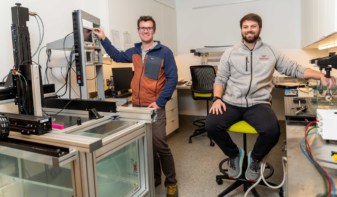
A new focused ultrasound approach — low-energy, rapid, short-pulsed ultrasound — can open the blood–brain barrier (BBB) using microbubbles and deliver drugs more uniformly and more safely than methods based on long ultrasound pulses. The technique, developed at Imperial College London and tested with laboratory mice, may eventually be used to deliver therapeutic agents and other compounds for treatment, diagnosis and study of neurologic diseases (Radiology 10.1148/radiol.2019181625).
Pre-clinical investigations into methods to safely penetrate the BBB are taking place at a global level. Focused ultrasound technology has the potential to revolutionize treatments of diseases such as Parkinson’s and Alzheimer’s, as well as brain tumours. But while focused ultrasound using long-pulse sequencing and microbubbles can disrupt the BBB and allow drugs to pass through the vessel lumen, concerns exist about the effectiveness and safety of such long-pulse sequences. Potential issues include unequal distribution of delivered drugs and biological responses such as haemorrhage, red blood cell extravasation and neuronal damage. Additionally, it takes between four and 48 hours for the permeability of the BBB to return to its natural state, allowing undesirable blood components like albumin to cross the BBB and cause neurotoxicity.
The Imperial College London researchers developed their technique to mitigate potential damage caused by long-pulse sequencing. They selected rapid, short-pulse sequence parameters to provide a time interval for microbubbles to move between pulses and not overstress any given capillary site, and chose burst-sequence parameters that allow microbubbles to replenish the vasculature exposed to the ultrasound beam. They hypothesized that this combination of short pulses and rapid emission would allow each microbubble to be gently stimulated multiple times as it flowed through the vascular network.
The researchers tested their technique on 28 female wild-type mice. They systemically administered microbubbles and the drug dextran immediately prior to the ultrasound, or at 10 or 20 minutes afterwards. Fourteen mice had their left hippocampus exposed to low-energy short pulses, specifically a pulse length of five cycles and a pulse repetition frequency of 1.25 kHz. The burst length was 10 ms or 13 pulses, and the burst repetition frequency was 0.5 Hz at 125 bursts.
The other 14 mice also had their left hippocampus exposed, but to long-pulse sequences that contained 150 times more acoustic energy. The pulse length was 10,000 cycles, with a pulse repetition frequency of 0.5 Hz at 125 pulses. The researchers used a peak negative pressure of 0.35 MPa for both groups as it is just above the acoustic pressure threshold for drug delivery.
Co-author James Choi, who leads the Noninvasive Surgery and Biopsy Laboratory at Imperial, told Physics World that the microbubbles, when activated by the ultrasound, volumetrically expand and contract within the capillaries and cause molecules within the blood plasma (such as the administered drug, for example) to be transported across the BBB. “How this transportation occurs remains a mystery,” he added.
The rapid, short-pulsed sequence delivered dextran in a uniform pattern in the ultrasound beam, providing complete coverage of the targeted tissue, reported lead author Sophie Morse, who won the Westminster Medal for this research at this year’s STEM for Britain competition. The long-pulse sequence did not, instead delivering high concentrations of dextran in some areas and none in others. The short-pulse sequence also was more efficient, producing 2.2 times more acoustic energy, as well as longer duration acoustic emissions than the long-pulse sequence.
The authors also determined that, with the short-pulse sequence, drug delivery only occurred within 10 minutes of ultrasound exposure. They observed that the BBB permeability returned to control levels in less than 10 minutes (compared with several hours for long pulses) and that only a limited amount of blood albumin was released into the brain, specifically 3.4-fold lower than with a long-pulse sequence.
“The rapid short-pulse sequence delivered dextran with a safety profile previously unachievable using ultrasound,” the authors stated.

Clinical trial explores BBB opening in fight against Alzheimer’s
The authors attributed these improvements in drug delivery to the stimulation of better cavitation distribution and a reduction of the cavitation magnitude and diversity with short-pulse ultrasound. They note that the sequence that they designed, which emits low-energy pulses at a carefully selected pulse repetition frequency, reduces microbubble destruction and allows microbubbles to move between excitations. All of these factors suggest that rapid short-pulse ultrasound is preferable to long-pulse sequencing.
The team is continuing its research, funded by Alzheimer’s Research UK, to determine how a rapid short-pulse sequence delivers drugs across the BBB and how this differs from delivery using long pulses. They plan to optimize the rapid short-pulse sequences for drug delivery by modifying the pulse shape and sequence, as well as the microbubbles themselves and their protocol of administration. They also plan to explore the use of rapid short-pulse sequences in other organs and diseases and to explore new pulse-sequence designs.



